Kenya
City Of Kenya
- Nairobi
- Mombasa
- Malindi
- Chogoria
- Embu
- Eldoret
- Garissa
- Homa Bay
- Isiolo
- Kajiado
- Kakamega
- Kendu Bay
- Kericho
- Kilifi
- Kissi
- Kisumu
- Kitale
- Kitui
- Kwale
- Lamu
- Limuru
- Lodwar
- Maralal
- Marsabit
- Meru
- Naivasha
- Nakuru
- Nanyuki
- Narok
- Nyahururu
- Nyeri
- Taveta
- Thika
National Parks
- Aberdare
- Amboseli
- Hell's Gate
- Isola Ndere
- Kerio Valley
- Lake Nakuru
- Malka Mari
- Marsabit
- Meru
- Mombasa
- Mount Kenya
- Mount Longonot
- Nairobi
- Ruma
- Tsavo East
- Tsavo West
- Sibiloi
- Arabuko Sokoke Forest
- Victoria Lake
National Reserves
- Arawale
- Boni
- Dodori
- Tana River Primate
- Kakamega Forest
- Kiunga
- Kora
- Rahole
- Masai Mara
- Mpunguti
- Shimba Hills
- South Kitui
Marine Parks
Marine Reserves
Provinces of Kenya
Nairobi
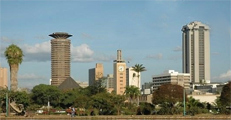
A natural base for excursions in the surroundings of Kenya, the capital Nairobi is not only the gateway in the wonders of the country but offers a few surprises itself.
This is the cultural capital of the nation and you must not omit to visit at least the National Museum before going out to see the richness and the beauty of Kenya. This institution now houses the findings of archaeological sites like Olduvai - the location of the oldest human remains ever discovered.
Other attractions include theaters, restaurants and the pleasure of shopping in the Maasai Market (not the best place in the nation to take tribal arts and handicrafts, but certainly one of the easiest). Or, within a short leap of the city you can see the orphan rhinos and elephants in the David Sheldrick Center, make an excursion in the Ngong Hills (still home for the lions), and visit the long neck of the Giraffe Center and the Nairobi National Park.
More information about Nairobi
Mombasa
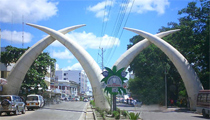
Located on the sands of Indian Ocean, Mombasa is amalgaming history with present, and a walk through the streets of the old city brings visitors through a confluence of cultures. The Portuguese were here in past centuries, the city has a comfortable footing in the north-east of the coast of Africa.
The influence of these settlers is still tangible, more on the Fort Jesus. Still protecting the coastal port of the capital 300 years after it was built in 1593, the walls of the old arsenal now hide a museum.
Once you've visited this relic of the past, see the story of life in the markets of the city. The Makupa Market is typically African, full of noise and energy and a great place to buy traditional textiles and works of art.
Or you can go to the floating market in a stream on the northern city. To have dinner in one of the best restaurants in the continent, the Tamarind, is obligatory, especially for those whom love the marine food. Although the main sources of Mombasa are now a large modern port is still possible to see many of the traditional wood ships Dhow that have sailed these waters for years. You can also make a trip on the local coast - or try a night under the moon and travel to watch the stars.
More information about Mombasa
Malindi
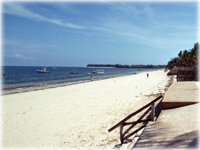
Is the capital of the homonym district in the Coast province and has about 110,000 inhabitants. The city's main industry is tourism and is very popular among Italian tourists. From the fourteenth century was a Swahili settlement and in the past the only rival in this part of East Africa was the city of Mombasa. It was visited in 1414 from the fleet of Chinese explorer Zheng He and in 1498 by Portuguese explorer Vasco da Gama that has built here a pillar taht still exists. It has survived many traditional buildings that include the Juma Mosque and the palace on the beach, that is very popular among the tourists.
Chogoria
Is a town in Meru South District of the Eastern province, at a distance of about 225 km from the capital Nairobi. The city has a population of about 28,000 inhabitants and is one of the few access to the Mount Kenya .
Eldoret
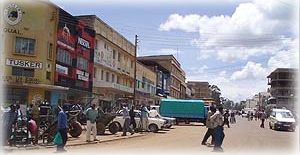
Is the capital of the Uasin Gishu North district in the Rift Valley province, with a height above the sea level ranging from about 2100 meters to more than 2700 meters in the surrounding areas . The city has a population of about 190,000 inhabitants and is growing rapidly.
Before the colonial era, the area was occupied by the Sirikwa, then by the Maasai and then by the Nandi. The city was founded in 1910 with a post office in place that the white settlers called it "Farm 64" because at that time were 64 miles from the Kibigori station recently built by Uganda railway. In 1912 the post office was renamed "Eldoret" and became an administrative center, causing an increase in trade. In 1924, the Uganda railway has arrived to the Eldoret beginning a new era of prosperity. It was installed a pipeline to supply water from the river Sosiani in 1928 and in 1933 was installed an electricity generator plant. Under the presidency of Daniel Arap Moi , which was born here, the city has developed more.
The city is known for its large market and the international airport, but also for its cheese factory. There are large textile industries and wheat industries.
In the city is the Moi University, the second medical school in Kenya and the Eldoret Polytechnic, the third National Polytechnic.
Eldoret is the birthplace for many runners, the most famous is Kipchoge Keino, they helped the city with their winnings in races all over the world.
Embu
Is the capital of the homonym district and the capital of Eastern province, has a population of about 41,000 inhabitants. Embu is a major shopping mall in the east of the country and for a long period of time was the main commercial center for the Aembu tribe and Ambeere tribe. Located at a height of 1350 meters above sea level, was founded in 1906 by the British colonizers. The city is known for its Jacaranda trees that transform the city in purple color when are blooming.
Garissa
Is the capital of the homonym district and the capital of the North Eastern province and has about 65,000 inhabitants who are mostly Somalis. The city provides an interesting Somali way of life and the has streets with shops painted in bright colors. Its industry is more concentrated in the food, beverage and tobacco products, and plastic containers.
Homa Bay
The city Homa Bay is the capital of the homonym district in Nyanza province. Located on the southern Winam Gulf of the Victoria Lake and near the Mount Homa. It has a population of about 55,000 inhabitants and is the most southern ferry stop and it is near the Ruma National Park.
Isiolo
Is the capital of the homonym district in Eastern province. It has an urban population of about 12,000 inhabitants and was born around the local military camp with most of the population coming from Somali ex-soldiers who fought in the First World War. The city is known for its large market and the local industry is the manufacturing of jewelry.
Kajiado
Is the capital of the homonym district in the Rift Valley province and has a population of about 8,000 inhabitants, mainly from the Masai tribe. The name derives from the word "Orkejuado" that in the Masai language means "The long river", from the river that runs in the west of the city.
Kakamega
Is the capital of the homonym district and the capital of the Western province. It has a population of about 73,000 inhabitants and is the third largest city of Kenya. Most of the inhabitants belong to the Luhya tribe, whose main activity is agriculture and fishing. The city has the Masindi Muliro University of Science and Technology. It was the scene of a race for gold in the early 30's. It receives a large amount of annual rainfall and contains the Kakamega Forest.
Kendu Bay
Is a city of the Rachuonyo district in the Nyanza province. It has a population of about 30,000 inhabitants and it's attraction is the deep volcanic lake near by. The area is the birthplace of the father and grandparents of the President of United States Barack Obama.
Kericho
Is the capital of the homonym district in the Rift Valley province and has an urban population of about 45,000 inhabitants. Here tou can find the best Kenyan tea, famous all over the world for its brightness, color and flavor, and is home to some of the most important runners in the world that win gold medals in international events.
Kilifi
Is the capital of the homonym district in the Coast province and has about 30,000 inhabitants. Kilifi is located on the coast and on the mouth of the Raro river. The Bofa beach is known as one of the best beaches in Kenya. Here are the Mnarani ruins.
Kissi
Is the capital of the homonym district in the Nyanza province and has about 70,000 inhabitants. Kisii is known as the seat of soapstone - a pink colored stone with drawings, extract from the nearby village of Tabak.
Kisumu
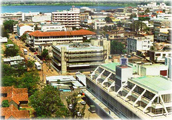
Is the capital of the Kisumu West district and the capital of the Nyanza province and is a port city situated at a height of 1131 meters above sea level, with a population of approximately 355,000 inhabitants. Kisumu is the main city of the western Kenya. The attractions include the Kibuye market, the Kisumu Museum, the impales sanctuary and the near by Kit Mikaye, the Hippo Point and the Ndere Island National Park.
Kitale
Is the capital of the Trans-Nzoia West district of the Rift Valley province. Located between Mount Elgon and the Cherengani Hills to about 2133 meters above sea level, has about 63,000 inhabitants. Kitale is a country that is based on agriculture, the main crops are in the field of sunflower, tea, coffee, pyrethrum, beans and corn. The city was founded in 1908 by white settlers and thanks to the Uganda Railway which reached the city in 1926, promoted the growth and the economic development.
Kitui
Is the capital of the homonym district in the Eastern province and has about 13,000 inhabitants. Even there is Nairobi near by, is one of the least developed areas in Kenya. Here is the local Kamba tribe, famous for the handmade woven baskets and carved wood with miniature sculptures of elephants, antelopes, lions, reptiles and necklaces.
Lamu
Is the capital of the homonym district in the Coast province and is the oldest Swahili settlement along the East Africa. It was invaded by the Portuguese in the early sixteenth century and then by the Oman in early nineteenth century, under them has become a center of poetry, politics, arts and crafts. Until 1907 the city's economy was based on the slave trade and the export of ivory, mangroves, turtle shells and rhinoceros horn. In recent times tourism has gradually recharged the local economy. In the city there are many examples of Swahili architecture, and the old city is listed on the List of World Heritage as "the oldest and best preserved Swahili settlement in East Africa".
Limuru
Is the capital of Kiambu West district in the Central province with a population of around 4800 people depends mainly on farming and on a shoe factory. In the early British colonial period, Europeans settled here because of its proximity to Nairobi, for the rail and especially for its fertile land, so the tea plantations set up around the city were the foundation of the largest export industry in Kenya.
Kwale
Is the capital of the homonym district in the Coast province and counts about 4,000 inhabitants. Kwale is the main city of Digo and Duruma people that belong to the ethnic group Mijikenda. Very important for small farmers to sell their products.
Lodwar
Is the capital of the South Turkana district of the Rift Valley province and has about 17,000 inhabitants are a mixture of people of Turkana tribe and the community of passing truckers. Its main industries are weaving baskets and tourism. Once it was known as the isolated outpost in the northern frontier of the district, now is connected to Kitale and the Central Highlands with a paved road.
Maralal
Is the capital of Samburu district of the Rift Valley province and has about 16,000 inhabitants. The city serves as a base for tourist activities such as rafting and camel riding, very famous for camel races. Nearby is the escarpment Losiolo, known as the "World's End", here the Rift Valley falls more than 2,000 meters in the Suguta Valley and is the longest perpendicular downhill in the Rift Valley.
Marsabit
Is the capital of the homonym district in the Eastern province and is almost surrounded by the Marsabit National Park. The city is an outpost of urban civilization in the vast desert of northern Kenya and is situated on an extinct volcano, the Mount Marsabit, which rises almost a mile above the desert. The inhabitants are Gabra, Rendile and Boram people, the last ones arrive from Ethiopia because of the famine of the'70s, but also Somalis migrants. Sometime close to the city there are elephants that cause damage to the crops of the local farmers.
Meru
Is the capital of the Imenti North district of the Eastern province and has about 42,000 inhabitants. The city is a business, agricultural and educational center into the north-east of Kenya. Here is an important area that produces coffee, but also tea, timber and dairy products. In the area grows the best "Mira"-a small plant that acts as a stimulant. There are universities like Emory University, Meru Technical Institute and Kenya Methodist University.
Naivasha
Is the capital of the homonym district in Rift Valley province and has about 14,000 inhabitants. The city is a popular tourist destination for its national parks. The main activity is agriculture, especially the flower-growing.
Nakuru
Is the capital of the homonym district and the capital of the Rift Valley province. Located at a height of 1850 meters above sea level, has about 300,000 inhabitants. The history of the area can be placed in the prehistoric period because of the archaeological discoveries found here. During the white colonization was part of the White Plateau and it continued to grow in a cosmopolitan city. For a long period of time it was the outbreak of politics and has been home for many politicians. The city is also a starting point for the Menengai crater , the prehistoric site Hyrax Hill and for the Aberdare National Park.
Nanyuki
Is the capital of Laikipia East district in the Rift Valley province and has a population of about 30,000 inhabitants. Founded in 1907 by the British settlers is now the main air base of the Kenya Air Force. Most of the population deals with trade and the shops of the city are supply for many farms and ranches in the area. The town lies near the equator in the southern part and for this reason the tourists make photographs here.
Narok
Is the capital of the Narok North district in the Rift Valley province, located at a height of 1827 meters above sea level, has about 40,000 inhabitants. The city is the main point of access to the Masai Mara Reserve and the last place of supply for over 100 kilometers. There are many souvenir shops and street vendor selling Masai shields and objects worked with beads. In the city you will notice the Maasai people with their traditional red clothes.
Nyahururu
Is the capital of the Nyandarua North district in the Central province and has about 24,000 inhabitants. The city was founded by the British settlers and grew up around a railway line, now used only for merchandise.
Nyahururu is the highest town in Kenya and the land of the best Kenyan athletes. There are so many private schools that most of the children in this area have succeded in life through education. Here is the famous waterfall Thompson Falls of 70 meters height of the Ewaso Nyiro river.
Nyeri
Is the capital of the Nyeri South district and the capital of the Central province and has about 98,000 inhabitants. From the city you can see the famous Mount Kenya. In early colonial period, Nyeri was a garrison and soon became a commercial center for the white farmers.
To the south of the city is the Wajee park where are buried Lord Robert Baden-Powell - fighter in the Boer War and founder of the Scout movement, his wife and the legendary hunter and conservative Jim Corbett who spent his last year of life in Kenya.
Taveta
Is the capital of the homonym district in the Coast province and has about 11,000 inhabitants most of them of Taveta tribes, but also Kambas, Kikuyus, Taitas and people from Tanzania. The city is surrounded on three sides by Tanzania and is a point of trade between Kenya and Tanzania. Its outdoor market is very large for a city of this size. Beside the Mount Kilimanjaro, the city enjoys the proximity of the Chala Lake a volcanic lake with fresh water and an extraordinary depth.
Thika
Is the capital of the homonym district in the Central province, located at a height of 1531 meters above sea level, has about 88,000 inhabitants. Here are the waterfalls Chania Falls and Thika Falls, well-known among tourists. Towards the end of the nineteenth century, foreigners began to settle in this outpost, Europeans formed the farms and the Asians created the shops. The tourist attractions are: the Mugumo Garden named so for the giant fig tree where the legendary Mugo wa Kibiro predict the fall of British rule in Kenya.










